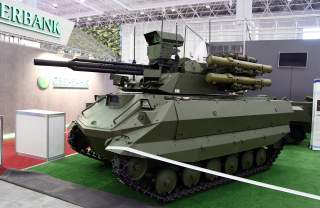One of Russia's Newest Pieces of Military Hardware Is Having a Big Problem
This new drone has some serious issues.
Russia has admitted that its Uran-9 combat drone has failed during operations in Syria.
During a presentation at an April conference in St. Petersburg, a researcher at the Russian Ministry of Defense reported multiple problems with the Uran-9, including poor reliability as well as control issues, according to the Defence Blog site.
The Uran-9 is an eleven-ton unmanned ground vehicle, though with its gun turret, perhaps calling it a robotic light tank is almost as accurate. The Uran-9 is a tracked vehicle can carry the armament of heavier manned vehicles, including a turret-mounted thirty-millimeter cannon, four Ataka anti-tank missiles, flamethrowers and a machine gun. Though just lightly armored against small arms fire, it is equipped with a laser warning system, and sensors that can detect targets out to four miles.
Coming soon after the unveiling of the next-generation T-14 Armata manned tank, the Uran caused a stir in the West when it was sent into combat in Syria this year. But A. P. Anisimov. a senior research officer in the the 3rd Central Research Institute of the Russian Defence Ministry, painted a damning picture of the vehicle's first combat tests.
Recommended: Why an F-22 Raptor Would Crush an F-35 in a 'Dogfight'
Recommended: Air War: Stealth F-22 Raptor vs. F-14 Tomcat (That Iran Still Flies)
Recommended: A New Report Reveals Why There Won't Be Any 'New' F-22 Raptors
“It became known that the Uran-9 complex is not capable of performing the tasks assigned to it,” Anisimov told the conference. “In particular, in carrying out of combat missions, the average range of sustainable management from the advanced control point was three hundred to five hundred meters [328 to 546 yards] in the conditions of the settlement with low-rise buildings, while also were recorded seventeen cases of short-term (up to one minute ) and two cases of long (up to 1.5 hours) loss of Uran-9 control.”
Reliability of the track rollers and and suspension springs was so poor that “the chassis of the Uran-9 cannot be used in ground close-combat roles for a long time and requires field repair.” The electro-optic sensors could only detect targets out to two kilometers [1.24 miles], while the vehicle couldn’t detect enemy targeting devices.
The Uran-9’s thirty-millimeter cannon also suffered multiple failures. Nor could the vehicle fire on the move, because its weapons and sensors are not stabilized. Keep in mind that the robot tank’s deployment to Syria was a test, and therefore the usual teething problems can be expected with components like the chassis and sensors. More troubling is the periodic loss of control with an armed robot. For example, were there any control problems when weapons were being fired?
While there is no indication that the Uran-9 will be autonomous—without a human in the loop to pull the trigger—autonomous-combat vehicles are coming because Artificial Intelligence is the only way to fully exploit the capabilities of robots. Yet news of control issues with an armed robot won’t reassure critics who fear a future of killer robots run amok.
Michael Peck is a contributing writer for the National Interest. He can be found on Twitter and Facebook.
Image: Wikimedia Commons

